State of Student Aid in Texas – 2018
Section 3: Profile of Texas College Students
Undergraduate Enrollment by Location and Sector (Fall 2016)
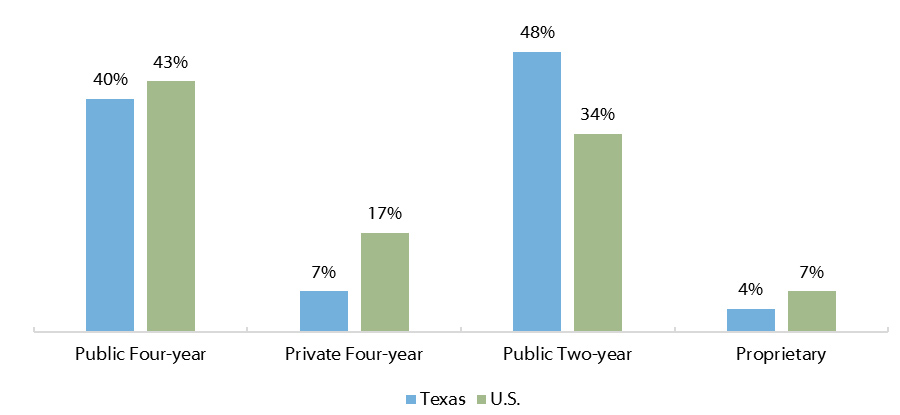
Almost half Texas undergraduates attended public two-year institutions in the fall of 2016, far more than the percentage of undergraduates nationwide in that sector. Texas undergraduates were less likely to be enrolled at private four-year or proprietary institutions compared to undergraduates nationwide, and about as likely to be enrolled at public four-year institutions.
Students who enroll at public two-year institutions are more likely to attend part-time compared to students enrolled in other sectors. Part-time students are at a greater risk of dropping out compared to those attending full-time, which is one of the factors that makes Texas undergraduates generally riskier than U.S. undergraduates.
Sources: U.S. Department of Education, National Center for Education Statistics, Integrated Postsecondary Education Data System (IPEDS) 2016 (http://nces.ed.gov/ipeds/).
Undergraduates by Classification and Sector (Fall 2015)
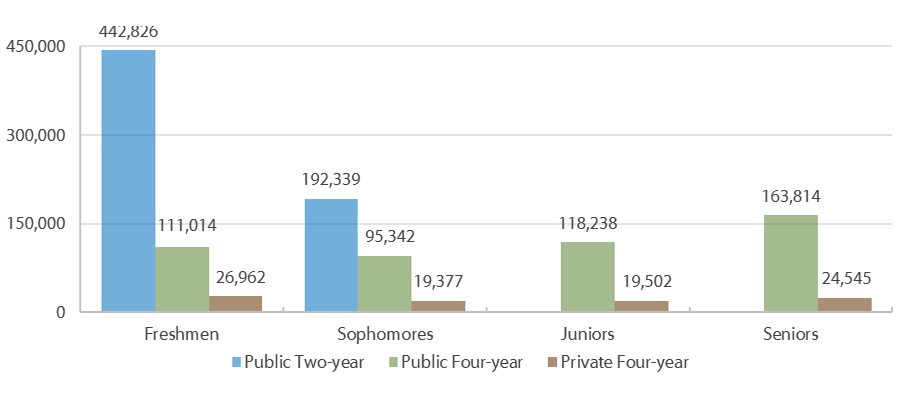
Texas Undergraduates by Race/Ethnicity and Sector (Fall 2016)
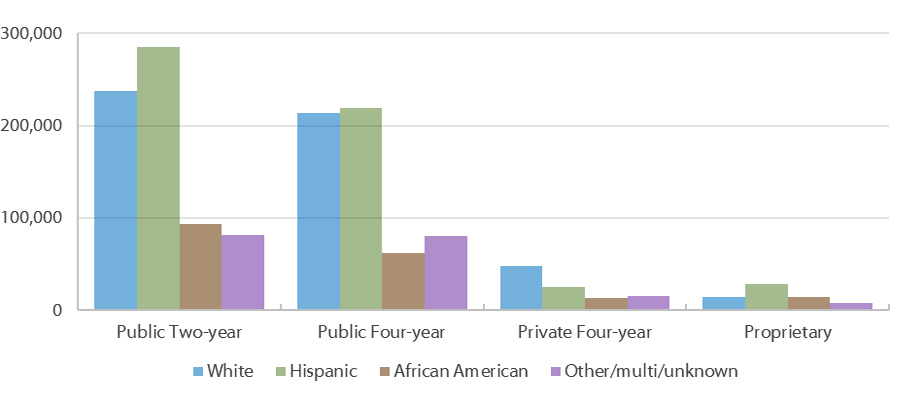
Public colleges and universities in Texas enrolled 1,337,724 undergraduate and 122,066 graduate students in fall 2015 (THECB; 2016 data above are from IPEDS to include proprietary institutions). Across all races/ethnicities, the number of undergraduates at public two-year institutions in Texas exceeds the number at public four-year institutions and far exceeds the number at private institutions, especially for freshmen. In fact, 80 percent of all freshmen attending Texas public institutions of higher education in fall 2015 were enrolled at two-year colleges (up from 76 percent in fall 2000), and only 20 percent were enrolled at four-year universities.
Texas colleges and universities are exceptionally diverse. While White students represent a plurality at all but proprietary institutions, they are not the majority of students in any sector.
Sources: Enrollment by classification: Texas Higher Education Coordinating Board (THECB), Texas Higher Education Data, Profile Reports Electronically Produced (PREP), Enrollment Statewide by Institution Type and Classification (http://www.txhighereddata.org/Interactive/PREP_New/). Enrollment by race (fall 2016): U.S. Department of Education, National Center for Education Statistics, Integrated Postsecondary Education Data System (IPEDS) 2016 (http://nces.ed.gov/ipeds/); Enrollment by race (fall 2016): Texas Higher Education Coordinating Board (THECB) 2016 higher Education Almanac Institutional Comparison Sheets (http://www.thecb.state.tx.us/index.cfm?objectid=A44B548A-E50C-8417-E09BF83FC11EA1EF).
Enrollment Intensity of Undergraduates in Texas and the U.S. (Fall 2016)
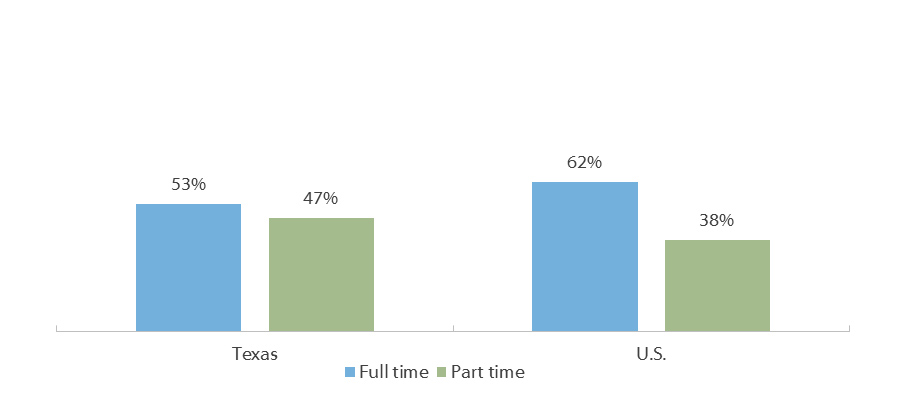
Enrollment Intensity of Undergraduates in Texas by School Sector (Fall 2016)
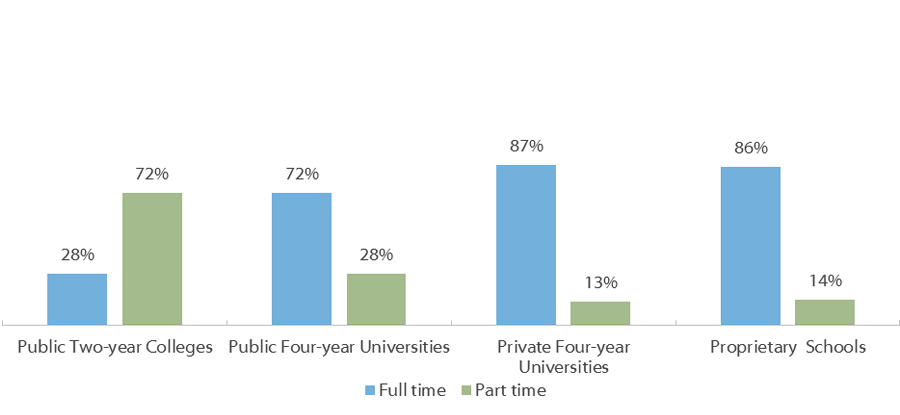
Part-time enrollment is more common in Texas than in the nation as a whole. As of fall 2016 about 53 percent of undergraduates in Texas were classified as full-time students. Full-time attendance is most common at private four-year universities, followed closely by proprietary colleges, then public four-year universities. At public two-year colleges, the largest sector by enrollments, a little less than a third of students attend full-time. Reasons for part-time enrollment vary but may pertain to financial concerns, like having limited funds for school expenses, trying to avoid student loans, or working more to provide for oneself and/or family. For several reasons, students who attend part-time are more likely to drop out of school.
Sources: U.S. Department of Education, National Center for Education Statistics, Integrated Postsecondary Education Data System (IPEDS) 2016 (http://nces.ed.gov/ipeds/); Fall 2015: Texas Higher Education Coordinating Board (THECB) 2016 higher Education Almanac Institutional Comparison Sheets (http://www.thecb.state.tx.us/index.cfm?objectid=A44B548A-E50C-8417-E09BF83FC11EA1EF).
Age of Undergraduates in Texas and the U.S. (Fall 2015)
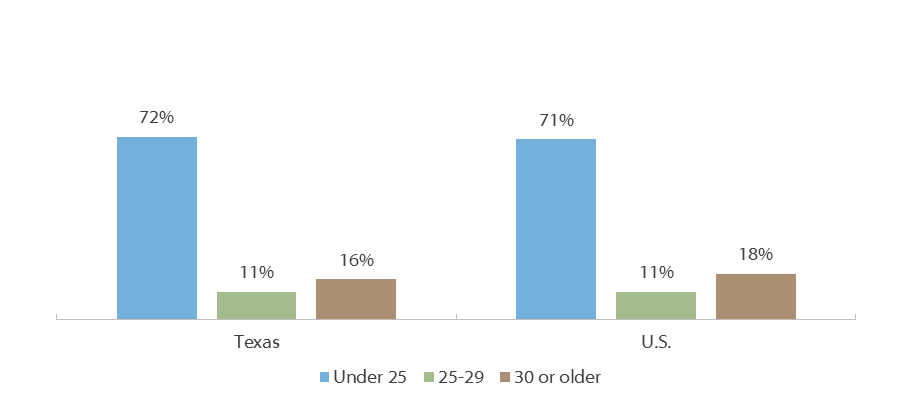
Age of Undergraduates in Texas by School Sector (Fall 2015)
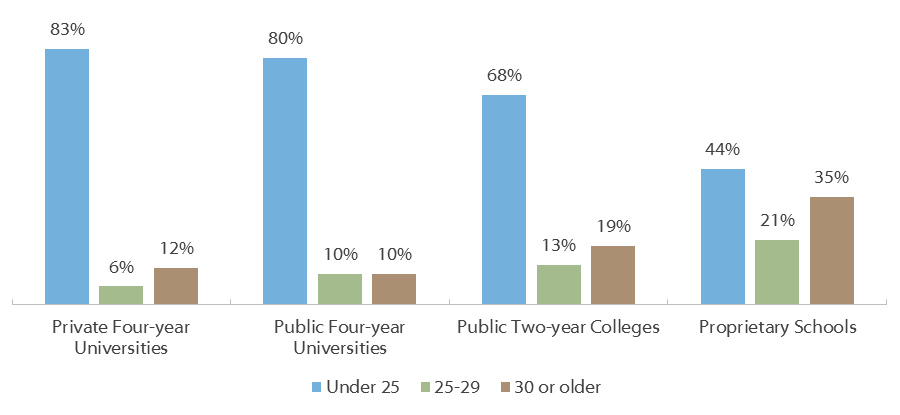
Of all Texas undergraduates in fall 2015, 72 percent were under age 25, 11 percent were between age 25 and 29, and 16 percent were age 30 or older. In the U.S. as a whole, older undergraduates are marginally less common, with 71 percent of fall 2015 undergraduates under the age of 25, 11 percent between age 25 and 29, and 18 percent age 30 or older.
About four in five undergraduates at public four-year universities and eight out of ten at private four-year universities are under the age of 25. At public two-year colleges, 68 percent of students are under age 25. Proprietary schools and public two-year colleges have higher percentages of older undergraduates. About 35 percent of undergraduates at proprietary schools and 19 percent of undergraduates at public two-year colleges are age 30 or older.
Sources: U.S. Department of Education, National Center for Education Statistics, Integrated Postsecondary Education Data System (IPEDS) 2016 (http://nces.ed.gov/ipeds/).
Percent of Top 10% Admits Among First-Time Texas Public Four-Year University Students (Fall 2015)
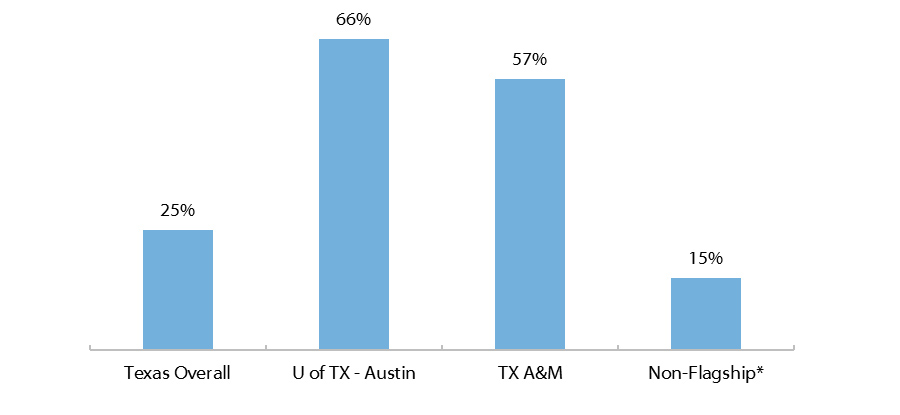
While the majority of first-time students at Texas’ two public flagship universities – the University of Texas at Austin and Texas A&M University – are drawn from the top ten percent of Texas high school classes, the far majority of students at Texas public universities are not. Top ten percent graduates account for about 25 percent of all first-time Texas public university students and only about 15 percent* of first-time students at the non-flagship universities, which account for about 82 percent of all Texas public university undergraduates. In fact, while top ten percent graduates are somewhat more likely than other students to enroll at a public university, they are in the minority at all non-flagship institutions.
As of fall 2015, 25.3 percent of first-time public university students were top ten percent admits. Only one out of 34** non-flagship public universities exceeded this proportion: the University of Houston, at 26.9 percent. Three others exceeded 20 percent: the University of Texas at Dallas (24.8%), the University of Texas at Arlington (23.9%), and the University of Texas of the Permian Basin (22.2%).
Eleven public universities had first-time classes whose share of top ten percent enrollment was less than ten percent.
*Estimate based on applying the percentage of top ten percent graduates among first-time students to the number of enrolled freshmen-level students.
**This is the number of non-flagship public universities for which the THECB had data on the percentage of top 10 percent enrollments. There are 39 Texas public universities in total.
Source: Texas Higher Education Coordinating Board (THECB) 2016 higher Education Almanac Institutional Comparison Sheets (http://www.thecb.state.tx.us/index.cfm?objectid=A44B548A-E50C-8417-E09BF83FC11EA1EF); Non-flagship estimate: Texas Higher Education Coordinating Board (THECB), Texas Higher Education Data, Profile Reports Electronically Produced (PREP), Enrollment Statewide by Institution Type and Level (http://www.txhighereddata.org/Interactive/PREP_New/).
Percent of Undergraduate Enrollment that is First Generation,* Nationally by Year
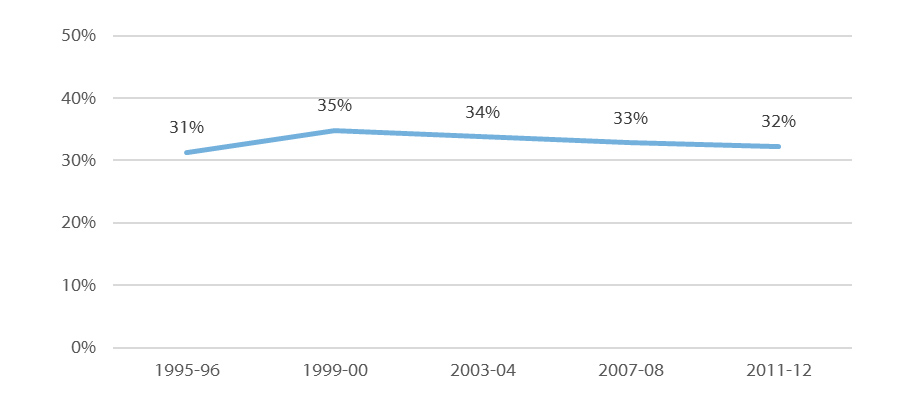
Students who are the first in their families to attend college make up about a third of undergraduates in higher education institutions across the U.S. This proportion has held fairly steady since at least the 1995-96 academic year. Nearly half of the students at proprietary schools are first generation, compared to about a quarter at public four-year and private four-year universities and over a third at public two-year colleges.
Percent of Undergraduate Enrollment that is First Generation,* Nationally by School Type for Academic Year 2011-12
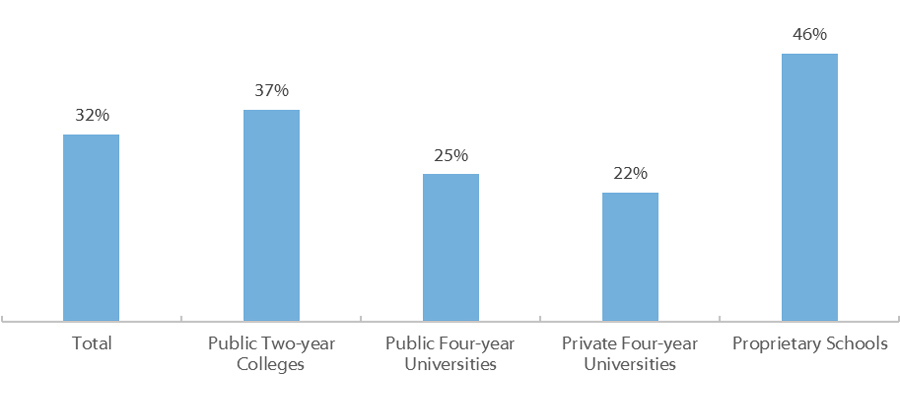
* First generation for this purpose is defined as students who have parents with the highest level of education attained by either one as high school or below. This does not include those with parents who attended some college or those who are unsure of their parents’ educational levels.
